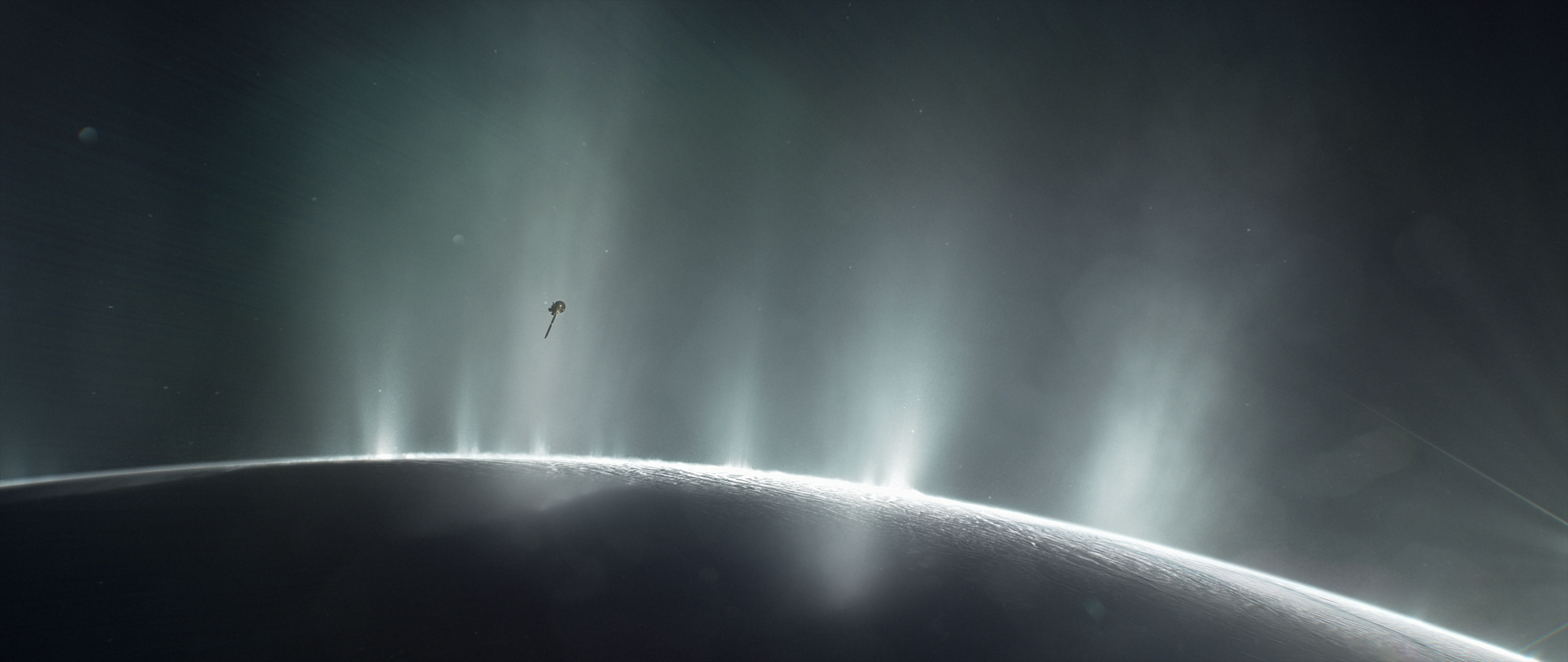
This illustration shows Cassini diving through the Enceladus plume in 2015. New ocean world discoveries from Cassini and Hubble will help inform future exploration and the broader search for life beyond Earth. Credits: NASA/JPL-Caltech
NASA has provided some insight into the icy, ocean-bearing moons of Jupiter and Saturn that could one day lead to proof of life outside of Earth.
During an April 13 press conference, scientists from NASA’s Cassini mission to Saturn announced that a form of chemical energy that life can feed on appears to exist on Saturn’s Enceladus moon. Researchers on the Hubble Space Telescope report additional evidence of plumes erupting from Jupiter’s Europa moon.
“With this research we are making a big step forward to answering the question is there life out there,” Thomas Zurbuchen, associate administrator for NASA’s Science Mission Directorate at Headquarters in Washington, said during the press conference.
The researchers from the Cassini mission revealed that hydrogen gas, which could potentially provide a chemical energy source for life, is pouring into the subsurface ocean of Enceladus from hydrothermal activity on the seafloor.
Hydrogen’s presence could mean that microbes—if any exist there—could be use it to obtain energy by combining the hydrogen with carbon dioxide dissolved in the water.
“This is a very significant finding because hydrogen would be an important source of chemical energy for microbes,” Linda Spilker, Cassini project scientist at NASA’s Jet Propulsion Laboratory in Pasadena, said during the press conference.
Mathanogensis, a chemical reaction that produces methane as a byproduct, is at the root of the tree of life on Earth and could even have been critical to the origin of life on the planet.
Life requires liquid water, a source of energy for metabolism and the right chemical ingredients—primarily carbon, nitrogen, oxygen, phosphorus and sulfur and the Cassini has shown that Enceladus—a small, icy moon a billion miles farther from the sun than Earth—has nearly all of these ingredients for habitability.
The researchers have yet to find phosphorus and sulfur in the ocean, but they suspect them to be there because the rocky core of Enceladus is thought to be chemically similar to meteorites that contain the two elements.
The Cassini spacecraft detected the hydrogen in the plume of gas and icy material spraying from Enceladus during its last, and deepest, dive through the plume on Oct. 28, 2015. Cassini also sampled the plume’s composition during flybys earlier in the mission.
The scientists used these observations to conclude that nearly 98 percent of the gas in the plume is water, about 1 percent is hydrogen and the remaining gas is a mixture of other molecules including carbon dioxide, methane and ammonia.
The researchers took the measurement using Cassini’s Ion and Neutral Mass Spectrometer (INMS) instrument, which sniffs gases to determine their composition.
The new findings represent an independent line of evidence that hydrothermal activity is taking place in the Enceladus ocean and previous reports from 2015 suggest hot water is interacting with rock beneath the sea.
The new findings support that conclusion and add that the rock appears to be reacting chemically to produce the hydrogen.
In Jupiter, the newly imaged plume rises about 62 miles above Europa’s surface, while the one observed in 2014 was estimated to be about 30 miles high. Both plumes correspond to the location of an unusually warm region that contains features that appear to be cracks in the moon’s icy crust, seen in the late 1990’s.
According to the researchers, if the plumes and the warm spot are, linked it could mean water being vented from beneath the moon’s icy crust is warming the surrounding surface. Another theory is that water ejected by the plume falls onto the surface as a fine mist, changing the structure of the surface grains and allowing them to retain heat longer than the surrounding landscape.
Jim Green, director, Planetary Science Division at NASA Headquarters, said NASA will continue to examine these oceans.
“They are protected by an iced shell, much like a modern atmosphere protects our lives here on Earth and our ocean,” Green said during the press conference. “It is truly an exciting time for us to be able to probe those and truly understand what is happening in these oceans.”




